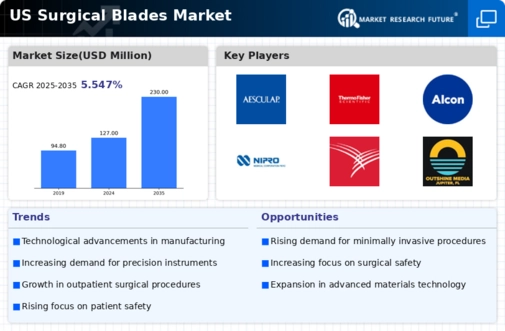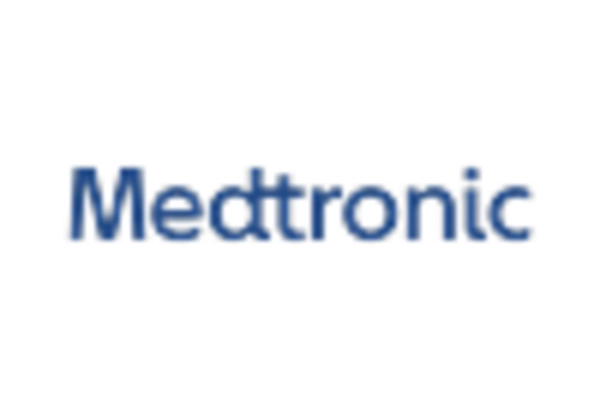Increased Focus on Patient Safety
The surgical blades market is significantly influenced by the heightened emphasis on patient safety and infection control within healthcare settings. Regulatory bodies and healthcare organizations are increasingly advocating for the use of single-use surgical blades to minimize the risk of cross-contamination and surgical site infections. In 2025, the market for single-use surgical blades is projected to account for over 40% of total sales in the surgical blades market. This shift towards disposable instruments reflects a broader trend in the healthcare industry, where patient safety is paramount. As hospitals and surgical centers adopt stringent safety protocols, the demand for reliable and safe surgical blades is likely to grow, further propelling the market forward.
Rising Demand for Surgical Procedures
The surgical blades market experiences a notable increase in demand due to the rising number of surgical procedures performed across various medical specialties. As the population ages and the prevalence of chronic diseases escalates, healthcare providers are compelled to perform more surgeries. In 2025, it is estimated that the number of surgical procedures in the US will reach approximately 50 million, driving the need for high-quality surgical blades. This surge in surgical activity directly correlates with the growth of the surgical blades market, as these instruments are essential for precision and efficiency in surgical operations. Furthermore, advancements in surgical techniques and the introduction of new procedures contribute to the expanding market, as healthcare facilities seek to equip themselves with the latest tools to enhance patient outcomes.
Expansion of Ambulatory Surgical Centers
The surgical blades market is positively impacted by the expansion of ambulatory surgical centers (ASCs) across the US. These facilities, which provide outpatient surgical services, are becoming increasingly popular due to their cost-effectiveness and convenience for patients. In 2025, the number of ASCs is expected to exceed 6,000, leading to a higher demand for surgical instruments, including blades. ASCs often focus on minimally invasive procedures, which require specialized surgical blades designed for precision and efficiency. This trend not only boosts the surgical blades market but also encourages manufacturers to innovate and tailor their products to meet the specific needs of ASCs, thereby enhancing market growth.
Technological Innovations in Blade Design
Technological innovations play a crucial role in shaping the surgical blades market, as manufacturers continuously develop advanced blade designs to enhance performance and usability. Innovations such as improved materials, ergonomic handles, and specialized coatings are being introduced to meet the evolving needs of surgeons. For instance, blades made from high-grade stainless steel or coated with anti-stick materials are gaining popularity due to their durability and effectiveness. In 2025, it is anticipated that the market for technologically advanced surgical blades will witness a growth rate of approximately 6% annually. This trend indicates that as surgical techniques evolve, the demand for innovative surgical blades will likely increase, driving the overall growth of the surgical blades market.
Growing Awareness of Surgical Instrument Quality
The surgical blades market is experiencing growth driven by the increasing awareness among healthcare professionals regarding the quality of surgical instruments. Surgeons and medical staff are becoming more discerning about the tools they use, recognizing that high-quality surgical blades can significantly impact surgical outcomes. In 2025, it is projected that the demand for premium surgical blades will rise, with a market share increase of approximately 15%. This trend is likely to encourage manufacturers to prioritize quality and performance in their product offerings, leading to a more competitive landscape within the surgical blades market. As healthcare providers strive for excellence in patient care, the emphasis on instrument quality will continue to shape purchasing decisions and market dynamics.

















Leave a Comment